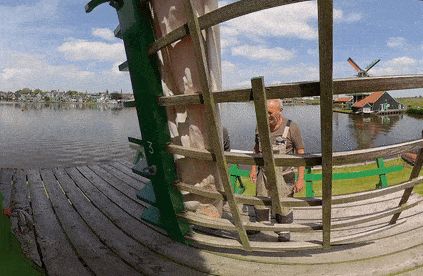
Sawmill 1867
The Crowned Poelenburg
This mill is of the Paltrok type. This type of mill has an open saw floor and when it is put to the wind, the entire mill, which weighs around 70,000 kilos, has to be turned.
As the working area is completely open on three sides, groups of tourists cannot visit this mill because of the risk of falling from the high saw floor.
1. When the mill has to be turned towards the wind, it is a heavy job that requires at least two men. To give the mill extra power for sawing, sails are attached to the wings to catch more wind.
2. This mill saws trees and beams into planks and slats. We start this story with a felled tree. You can’t saw it straight away because it contains too much sugars and starch, so it sits in water for a long time. This improves the quality of the wood. Not all wood floats, elms and oaks sink and stay there for at least six to eight years.
3. Before sawing, we drag the trunk ashore and remove the bark. The bark usually contains a lot of dirt and sand.
4. We lift the trunk with a winch and a crane powered by the mill. There we place it on the saw carriage and tie it down securely.
5. Now we need to adjust the sawframe. You can change the distance between the various saw blades using wooden blocks. This determines the thickness of the board to be cut. For sawing you need sharp saw blades, which we sharpen ourselves with a machine.
6. The saws only work downwards, upwards has no effect. So the log has to be pulled forward a millimetre at a time to saw. That’s what the scraper wheel is for. A pallet drops one tooth further each time.
7. How do these saws go up and down? It’s an invention from around 1597. This crankshaft serves 3 saw frames and it is located at the very top of this mill and it is connected to the sails. A crankshaft transforms a circular motion into an up and down motion. These saw frames are driven by long wooden beams from the crankshaft.
8. A number of other windmills along the Zaan can be visited inside. We at the Zaansche Molen hope you enjoy your visit and don’t forget to visit our mill museum.
Thank you in advance for your visit.



















